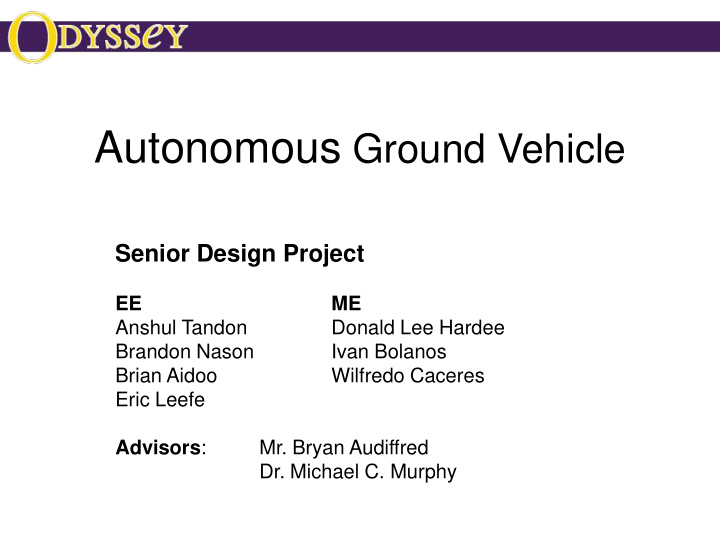



Autonomous Ground Vehicle Senior Design Project EE ME Anshul Tandon Donald Lee Hardee Brandon Nason Ivan Bolanos Brian Aidoo Wilfredo Caceres Eric Leefe Advisors : Mr. Bryan Audiffred Dr. Michael C. Murphy
IGVC - History and Description • June 8-11, 2007 in Rochester, Michigan, hosted by Oakland University • Autonomous Ground Vehicle Competition – Autonomous Challenge – Design Challenge – Navigation Challenge
Organization Chart • Software • Speed Control • Control • Steering • Sensor • E-Stop • Vision • Motor Navigation Propulsion Frame Power • Traction • Recharging • Body Material • Battery
Camera • Requirements – Lane & Pothole Detection • Part Specification – ImagingSource DFK 21F04 (Firewire) • Orientation – 5.5’ high – Front of vehicle – Tilted downwards approx 60° Image… http://www.imagingsource.com
Rangefinder • Requirements – Obstacle Detection • Part Specification – SICK LMS 291 (RS-232) • Orientation – 1’ high – Front of vehicle – Horizontal to ground Image… http://www.sick.com
GPS Unit • Requirement – Give accurate position • Magellan DG14 Sensor – Accuracy: 70 cm (with differential signal) – Interface: serial – Housing w/ prefabricated connections – NMEA protocol
Digital Compass • Requirement – Give accurate heading • KVH Azimuth 1000 – Accuracy: 0.5 degree – Serial interface – NMEA protocol
Propulsion • Motors Selection – Weight – Acceleration – Driving wheels – Wheel Radius – Coefficient of rolling friction – Linear and angular speed
Propulsion OUTPUT SHAFT RPM vs LIN VEL (r = 0.1524m = 6in) 300 250 200 RPM 150 100 50 0 0 0.4 0.8 1.2 1.6 2 2.4 2.8 3.2 3.6 4 LIN VEL (m/s) Speed Limit = 5mph = 2.234m/s
Torque Required TORQUE VS VEHICLE WEIGHT 24 22 20 Ur COEFF= 0.04 Tq (N-m) Ur COEFF= 0.05 18 Ur COEFF=0.08 16 Ur COEFF=0.09 Ur COEFF=0.06 14 12 10 60 64 68 72 76 80 84 88 92 96 100 W (Kg)
Torque Required TORQUE VS VEHICLE WEIGHT 17 DEG INCLINE 45 40 Tq (N-m) 35 Ur COEFF=0.06 30 25 20 60 64 68 72 76 80 84 88 92 96 100 W (Kg)
Propulsion • The motor we selected is the NPC R-82
Propulsion RPM vs.Torque 250 230 210 190 RPM 170 150 130 110 1.2 6.4 11.6 17.4 22.3 27.9 32.9 38.0 43.1 48.2 Torque (N-m)
Propulsion Current vs. Torque 80 70 60 Current (amps) 50 40 30 20 10 0 1.2 6.4 11.6 17.4 22.3 27.9 32.9 38.0 43.1 48.2 Torque (N-m)
Motor Controller • AX3500BP – Current Requirements • Motor current: 40 A • Max continuous controller current: 60 A – Serial-to-PWM converter – Controls both motors – Accepts feedback – PID control
Control Loop - Block Diagram CPU AX3500BP Motor 1 Motor 2
Traction and Steering • Requirements – Low cost – Reliability – Low weight – Low turning radius – Max speed of 5 mph – Stability – Good traction in grass and sand • Solutions – Four wheels with rack and pinion steering – Track with differential steering – Wheels with differential steering (Chosen)
Traction and Steering
Power System Design • Batteries – 6 Powersonic Sealed Lead-Acid Batteries – Calculated battery life = 3 Hours • Charging – 2 Battery Tender Multibank Chargers • Monitoring – Serial Voltmeter Software
Power System Layout 12V/24V Battery Bank for Sensing and Processing Digital Camera Compass 12V 12V Box for Electrical 11.28W 0.1W Wiring, Fuses, Converter, and Computer GPS Unit Regulator 12V 12V 90W 3.7W Laser Range Finder 24V 20W 24V Battery Bank for Motors Motors 24V Variable Power
Frame Design Material Design • • Strength Layout • • Elasticity (bending deflection) Dimension Requirements • • Cost Water Resistance • • Weight Center of Gravity • • Weldability Component Mounting
Frame Design ANSI 1020 Coated Polyester • Yield Strength ~ 51,000 psi • Lightweight – Maximum stress on vehicle is • Breathable 4,700 psi • Inexpensive – Lowest FOS = 10.7 • Cost Efficient
Component Positioning
Component Positioning
Component Positioning
Component Positioning
Component Positioning
Component Positioning
FEA - Stress and Deformation Maximum Stress = 4,700 psi Average Stress = 2,300 psi
FEA - Stress and Deformation Maximum Deflection = 0.023 in Average Deflection = 0.012 in
Processing • Personal Computer • GPU Acceleration • OpenVIDIA Graphics Library • C Programming Language • Multithreading
Processing Encoder Motor Motor Controller GPS Compass Computer Rangefinder Camera Monitor Keyboard
Software Flow Chart Initial State Gather data Camera Rangefinder GPS Unit Compass Store Data Get Direction Move Vehicle
Navigation Algorithm Send Gather data Identify Process Determine direction to from target GPS heading motor sensors directions coordinates correction controllers
Lane & Pothole Detection • Capture image from camera • Convert image to B/W • Downscale image • Detect white pixel chains • Detect white pixel areas • Determine direction
Obstacle Detection • Get image from rangefinder • Determine distance to obstacles • Determine optimal direction
Emergency Stop • RF Communication – 433MHz – 250ft Receiver Transmitter Transmitter Receiver E-Stop Motors
Budget Category Part Cost Category Total Navigation LRF 6,000 Camera 250 GPS 3,700 Compass 400 10,350 Power Batteries 310 310 Propulsion Wheels 300 Motors 1,050 1,350 Frame Tubing 70 70 Processing On-Board CPU 1,185 1,185 TOTAL ~13,500
AGV - Past Competitions Images… http://www.igvc.org/photos.html
Summary • Navigation – Camera – Laser rangefinder – Differential GPS Unit – Central Processing Unit • Propulsion – DC motors – Wheels • Power – Rechargeable efficient batteries • Frame – Strong, light material
Questions / Suggestions • Contact area experts – Navigation -Vision Anshul Tandon – Navigation - GPS Eric Leefe – Propulsion Ivan Bolanos – Propulsion Wilfredo Caceres – Power Brian Aidoo – Frame Donald Lee Hardee – Processing Brandon Nason Sponsors :
Recommend
More recommend